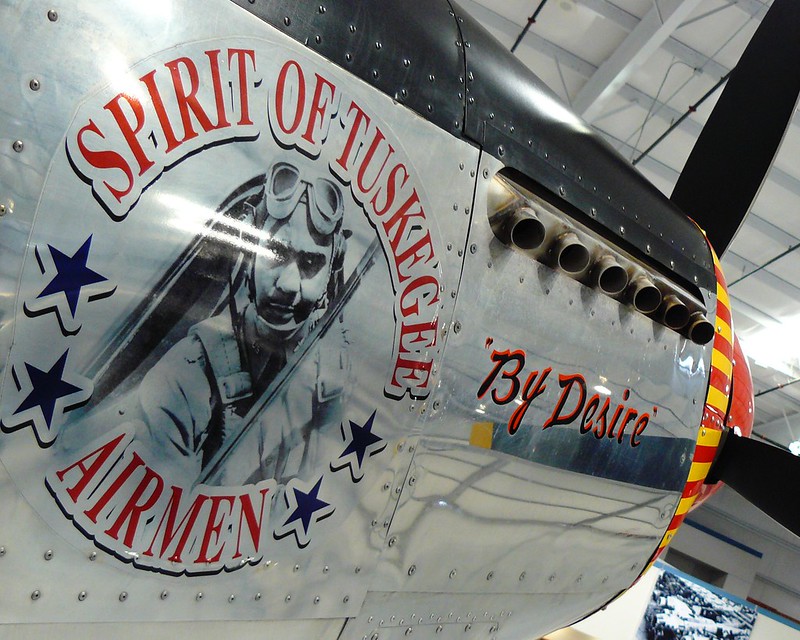The death of Charles E. McGee last week occasioned an outpouring of tributes to the Tuskegee Airmen, the all-black units of American military aviators of whom McGee was one of the last surviving members. What is not widely known is that the history of the Tuskegee pilots is connected to the controversy over the Roosevelt administration’s refusal to bomb Auschwitz during World War II.
Defying racist War Department officials who regarded them as inferior and did not want them to fly, the Tuskegee Airmen scored extraordinary achievements in battle. Tuskegee squadrons shot down more than 100 German planes and repeatedly won Distinguished Unit Citations and other medals. They were so admired by their fellow pilots that other bomber groups often specifically requested the segregated Tuskegee units as escorts for their bombing raids.
On the morning of Aug. 20, 1944, a group of 127 American B-17 bombers, called Flying Fortresses, approached the sprawling Auschwitz complex. The site included the mass-murder section known as Birkenau as well as an industrial zone where Jewish slave laborers worked in factories that produced synthetic oil for the German war effort. The bombers that day were escorted by 100 P-51 Mustang fighter planes. Most of the Mustangs were piloted by members of the Tuskegee Airmen’s 332nd Fighter Group, including Charles McGee.
Throughout the previous two and a half months, Jewish organizations had been asking the Roosevelt administration to bomb the gas chambers and crematoria in Auschwitz, as well as the railways and bridges leading to the camp.
For example, the president of Agudath Israel, Rabbi Jacob Rosenheim, pleaded with the administration to undertake “an aerial bombardment of the most important railway junctions of Kaschau and Presov, through which the deportation-trains pass.” The U.S. Labor Zionists submitted a similar appeal, at the request of Golda Meir (then known as Goldie Myerson), one of the leaders of the Jewish community in British Mandatory Palestine.
U.S. officials responded that such air strikes were “impracticable” because they would require “diversion of considerable air support essential to the success of our forces now engaged in decisive operations.”
But that was false. The planes would not have had to be “diverted” from elsewhere in Europe—as proven by the fact that U.S. pilots, including McGee and other Tuskegee Airmen, repeatedly flew directly over, or very close to, Auschwitz.
In the Aug. 20 raid, the attacking force dropped more than 1,000 500-pound bombs on German oil factories less than five miles from the gas chambers. Despite German anti-aircraft fire and a squadron of German fighter planes, none of the Mustangs was hit and only one of the American planes was shot down. All of the units reported hitting their targets.
On the ground below, Jewish slave laborers, including 15-year-old Elie Wiesel, cheered the bombing. In his best-selling memoir, “Night,” Wiesel described their reaction: “We were not afraid. And yet, if a bomb had fallen on the blocks [the prisoners’ barracks], it alone would have claimed hundreds of victims on the spot. But we were no longer afraid of death; at any rate, not of that death. Every bomb that exploded filled us with joy and gave us new confidence in life. The raid lasted over an hour. If it could only have lasted ten times ten hours!”
But it did not. The gas chambers and crematoria were never targeted, even though there were additional U.S. bombing raids on Nazi industrial sites in the Auschwitz region in the weeks and months to follow—including attacks on Aug. 27 and Sept. 13 in which the Tuskegee Airmen participated.
Similarly, McGee and his fellow pilots were repeatedly sent to take part in attacks on railways and bridges in Hungary—but never the ones named in the Jewish organizations’ requests. For example, on Aug. 28, the 332rd Fighter Group of the Tuskegee Airmen escorted bombers hitting the Miskolc Min train marshalling yards north of Budapest. On Sept. 17, the 332rd participated in an attack on the Rakos train marshalling yards, located in Budapest.
The next day, the Tuskegee Airmen took part in the 304th Bombardment Wing’s attack on railroad bridges in Budapest. And on Sept. 21, they escorted B-17 bombers striking the Debreczen marshalling yards, east of the Hungarian capital.
The Roosevelt administration knew about the mass murder going on in Auschwitz, and even possessed diagrams of the camp that had been supplied by two escapees. But it never gave the order to strike the mass-murder machinery or the transportation routes leading to it.
President Franklin D. Roosevelt’s policy was to refrain from using even minimal military resources in connection with humanitarian goals, such as interrupting the mass murder of the Jews. U.S. officials did not want to deal with what they called the “curse” and “burden” of caring for large numbers of refugees. The president and his administration failed to confront one of history’s most compelling moral challenges.
The refusal to bomb Auschwitz remains the most powerful symbol of the U.S. government’s failure to do what should have been done. And the Tuskegee Airmen were eyewitnesses to the fact that it could have been done.
Dr. Rafael Medoff is director of the David S. Wyman Institute for Holocaust Studies and author of more than 20 books about the Holocaust and Jewish history.
This article was first published by the Jewish Journal.


























